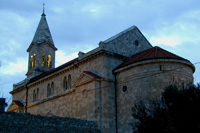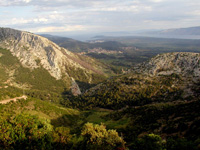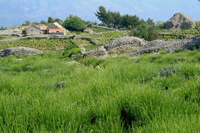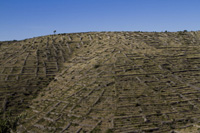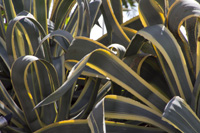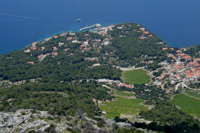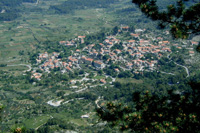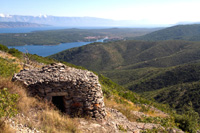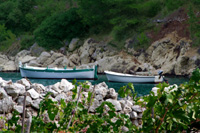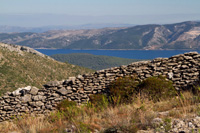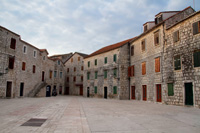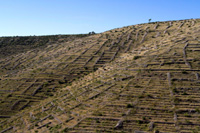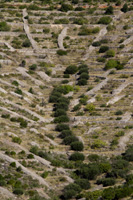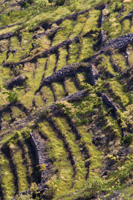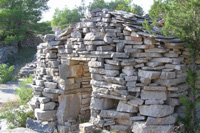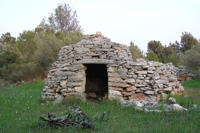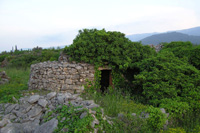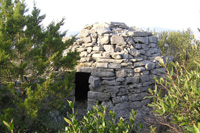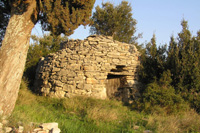
ilirios hvar tours : split to hvar
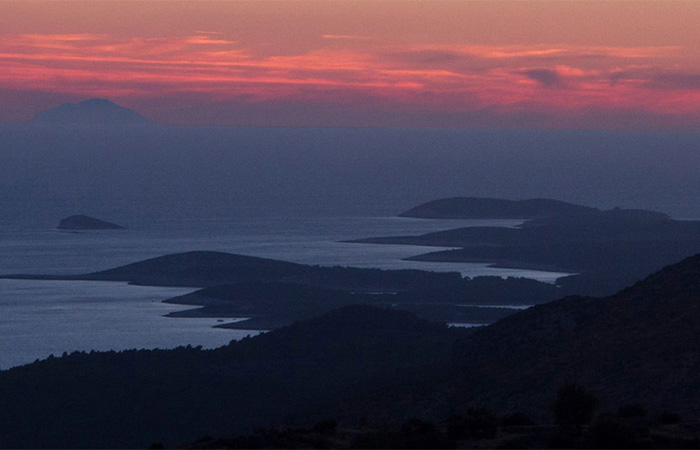
Hvar Island
 The island of Hvar is compact unit with plenty of contrasts, beautiful and inseparable in all its varieties. I hesitate to write something about it because I wonder if there is any sense to explore this exceptional island only by means of maps, photographs and words. I am aware that the only way to experience the Hvar island is to stay on it. There are a lot of particularities of Hvar that you will not find in this text or in any other text. Diversity of sceneries, inhabited since ancient times, rich in history, fashonable resort, desert of fragrant flowers are only some of the attributes of this island usually described by using superlatives.
The island of Hvar is compact unit with plenty of contrasts, beautiful and inseparable in all its varieties. I hesitate to write something about it because I wonder if there is any sense to explore this exceptional island only by means of maps, photographs and words. I am aware that the only way to experience the Hvar island is to stay on it. There are a lot of particularities of Hvar that you will not find in this text or in any other text. Diversity of sceneries, inhabited since ancient times, rich in history, fashonable resort, desert of fragrant flowers are only some of the attributes of this island usually described by using superlatives.
The coastline of Hvar has more coves than any other Adriatic island. Opposite the town of Hvar there is a beautiful archipelago called Paklinski islands. Thanks to Paklinski island as well as some other small islands and rocks in its vicinity, Hvar contributes considerably to Croatian nautical tourism. In the hidden coves of the island there are numerous pebble and stony beaches. Besides being ideal for sunbathing, the rocks on the northern shore of the island also keep the secret about his geological past.
About a hundred years ago a lot of fossils of sea fish and lizards from Cretaceous were discovered on the flat pieces of stone which were collected for covering roofs of various buildings. The fossils have finished up partially in private collections of wealthy islanders, partially in churches; many of them are also exhibited in museums in Zagreb, London, Munich, Trieste, Vienna. A lot of houses are still covered by pieces of stone with fossil imprints. It is, at the same time, confusing and amazing to be aware that many roofs on the island of Hvar contain valuable geological remains.
In 2004 an expedition of Canadian and Croatian palaeontologists and geologists, led by Dr Michael Coldwell and financially supported by National Geographic, was looking for fossil remains of prehistoric sea snakes and lizards. According to the study Gorjanovic- Kramberger from Croatian National Museum their traces had been discovered more than a hundred years ago. The repeated search for fossil traces of Aigialosauros Dalmaticus Kramberger-Cenomanian mosasauroid lizards was not successfull, however the foot-prints of three donosauros were discovered.
These traces belong to long-necked giant dinosauros, the last of giant sauropodus, magnificient titanosauros. That was the first time that the existence of a trail of dinosauros footprints was proved on the present day Dalmatian coast and islands, or ancient Tethys sea. 90 million years old dinosauros footprints represent one of the unsufficiently explored assets of the island of Hvar. So, if you wish to go for a swim in this part of the island, it's quite likely that you come across fossil imprints or some bigger remains with strange shapes.
If you ( or your children) would like to have a unique souvenir inspired by dinosauros, sea lizard or other prehistoric beings of the island of Hvar, please visit our agency-souvenir shop.
The area where the traces of dinosauros were discovered is situated in the northen part of the island, not far from the Field of Stari Grad ( Velo polje).
The Field of Stari Grad, that covers an area of 1200 ha, is devided into rectangles of 905x181m. These rectangles are noticed the best on satellite pictures, but those are not traces of an extraterrestial civilisation, these rectangles made of dry-stone walls represent the best preserved ancient Greek land parcel system. Chora of Pharos is located in the largest fertile field on the Croatian islands. In the Field of Stari Grad there are a lot of archeological remains from neolithic period as well as Illirian, Greek, Roman and times. Thanks to the abundance of red fertile land, created by erosion of limestone, vine, olive and lavander are grown in this field. The best preserved ancient Greek land parcel system, protected by UNESCO, is surrounded by hills (higher hills on the southern edge of the field and lower ones on the northen boundery) and overlooked by the highest point of the island- Saint Nicholas.
The mount Saint Nicholas, 628 m above sea level, affords a spectacular panoramic view that you'll never forget. From this point you can admire a big part of the island of Hvar as well as the surrounding islands . There's nowhere else on our islands a viewpoint that allows you to see such a wide area as it is the case here. Those who already had the opportunity to climb to the highest peaks of some other Croatian islands will certainly appreciate the advantages of Saint Nicholas.
At the foot of Saint Nicholas, in the southern part of the island, there's village Sveta Nedjelja. Well known wine producer Zlatan Plenkovic from Sveta Nedjelja keeps a part of his wine production in an unusual place-in the tunnel situated at an altitude of 450 m with permanent temperature of 12 degrees Celsius; another part of his wine production is kept in a cellar below the surface of the sea with a window looking at underwater world. These wines are made from grape ripened in the vineyards planted on the steep hillsides. As the slopes are very steep (up to 50 degrees), labourers in these vineyards must work in semi-sitting position.
The Vineyards of Sveta Nedjelja and Ivan Dolac represent a wonderful cultivated landscape of Hvar. Cultivated or not, created by man or by nature- it does't matter, landscape of the island of Hvar is for me something the most beautiful I've ever seen on the Adriatic islands . I would like to come back to the first sentence of this text and repeat that the island of Hvar is "compact unit with plenty of contrasts, beautiful and inseparable in all its varieties". This statement refers mostly to the continous series of various sceneries and panoromic views you can enjoy on our excursions by land or by sea such as "Dalmatian Island Safari" and "Around the island by RIB-boats".
Although the island of Hvar is one of the largest islands on the Adriatic sea, in comparison with many Mediterranean islands it isn't very large. It seems incredible that so many exceptional attractions can be seen on a such a small area (299 km²): Cape of Kabal, the bay of Stari Grad, Paklinski islands, Stari Grad with its Field, the system of dry-stone walls, lavander fields in the village of Brusje, the town of Hvar, vineyards in Sveta Nedjelja and Ivan Dolac, the island of Scedro, Crvene stijene (Red cliffs), two coves of Zarace, Zacarbina with Poljica.
Rich flora of Hvar with more than 1000 species of flowering plants changes the colours of the island from early spring to late automn. Almost every day I bear witness to the astonishement of guests when they smell aromatic plants. Familiar with rosemary, lavander, sage and other aromatic herbs from their gardens with less sunshine , the guests don't expect so intensive smell of the same plants. On the island of Hvar these plants grow in completely natural conditions with plenty of sunshine, limited quantity of very fertile land and minimum of water.
The landscape of stony shapes
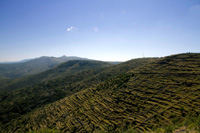 From the first Greek land division to the Roman or medieval ones, parcels of land on the island of Hvar were always devided in the same way- dry stone walls were built by putting pieces of stone in order. Differences in building techniques or stone arrangement were minimal: the walls differed from each other in their size, their width or height.
From the first Greek land division to the Roman or medieval ones, parcels of land on the island of Hvar were always devided in the same way- dry stone walls were built by putting pieces of stone in order. Differences in building techniques or stone arrangement were minimal: the walls differed from each other in their size, their width or height.
Recently I measured, just from curiosity, the quantity of stone used for erecting dry stone walls during the land amelioration (land improving) which started on the island of Hvar in 14 th century.
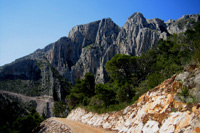 From the point where I was watching the magnificient valley covered by dry stone walls to the southeren entrance to the new tunnel, there's no more than 1500 m. This gorge or glen that is approximately 800 m long has an average width of 300 m and consists of at least 130000 cubic metres of stone. I had in mind the statement of our fellow-countrymen from continental parts of Croatia who use to say: "Dalmatian people are lazy."
From the point where I was watching the magnificient valley covered by dry stone walls to the southeren entrance to the new tunnel, there's no more than 1500 m. This gorge or glen that is approximately 800 m long has an average width of 300 m and consists of at least 130000 cubic metres of stone. I had in mind the statement of our fellow-countrymen from continental parts of Croatia who use to say: "Dalmatian people are lazy."
The area of land improving (amelioration) of this part of the island, from Dubov dolac to the cove Dubovica, might have belonged to the later erected farm with villa Garguric-Kasandric situated in the cove Dubovica. I had to repeat the measurement four times and obtain each time the similar result to be able to realize with amazement and respect that a human being had no a big choice of ways how to survive in the past. 130 000 cubic metres of stone are collected and put in order on the area of 3 square kilometers or a little larger. It means that the same quantity of stone is sufficient to cover the same area with the 40 cm thick layer.
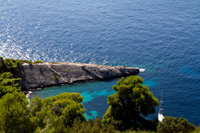 The layer of land on these parcels cultivated a long time ago, is very shallow.
The layer of land on these parcels cultivated a long time ago, is very shallow.
Croatian word "bonifikacija" could be translated into English as land improving or amelioration.
More precisely it meant the giving (as an act of 'grace') of unfertile pieces of karst land owned by the commune, mostly on the rocky tops of hills to the inhabitants who were interested in its cultivation. Larger fertile fields were kept in private ownership of rich land owners and the church, and the commune was renting 30 hoes of land per person regardless of sex equally to the commoners as to the noblemen who were obliged to cultivate the land continuously for 10 years. If they had stopped to cultivate the land, it would have been taken away by the commune. Karst slopes at a sharp angle were favourable for planting vinyards. At that time a great interest was shown for such an activity.
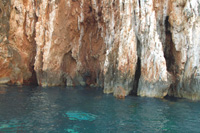 Dry stone walls that were built with stone removed from such a little fertile soil, form a network of square parcels with a little land in the middle. Tiny parcels on the hills were often build like steps so that they formed terraces. If you look at the large area covered by squares at present day, you realize how it was a hard work to create parcels suitable for cultivation on the higher karst slopes of the sunniest island of the Adriatic.
Dry stone walls that were built with stone removed from such a little fertile soil, form a network of square parcels with a little land in the middle. Tiny parcels on the hills were often build like steps so that they formed terraces. If you look at the large area covered by squares at present day, you realize how it was a hard work to create parcels suitable for cultivation on the higher karst slopes of the sunniest island of the Adriatic.
In winter these hills are continuously washed by rain, and therefore they always remain stony. Thanks to the action of rain, land and tiny pieces of stone together with minerals,are settled in the lower parts of hills creating small, fertile fields . These fields meander at the bottom of hills following the flow of rain water. Some wells can be also seen on these winding fields although the land retains water easier here.
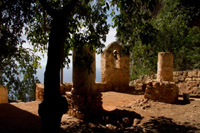 On our excursion "Dalmatian Islad Safari" we named these fields "green rivers".
On our excursion "Dalmatian Islad Safari" we named these fields "green rivers".
From the beginning of land improving (in Croatian 'bonifikacija') till present day a maximum of 10-12 cm of the new land has been created by surface erosion. A layer of 2 cm can be created in the period of 200 to 800 years.
I wonder how these uncultivated fields would look like if the things were solved like in the past.At the same time I am trying to imagine these tiny fields-terraces in purple of lavande as they looked in the last century or in green of vine as they had looked in the previous centuries. Even they are uncultivated and overgrown , these breathtaking creations of nature and man deserve admiration and respect.
In the vicinity of Primosten there are fields more remarkable than those on the island of Hvar for the quantity of built-in stone. The photo of these vineyards in Primosten with their dry stone walls is exhibited in the building of United Nations in New York representing acknowledgement and monument of human labour.
How is the environment politics in Croatia at all?. If 'the environment politics' means protection and preservation of nature, the lack of interest for such landscapes is the best contribution to that politics.
According to the information I have, the roofs of two stone cottages ( called 'trim' on the island of Hvar) have fallen down last year. I don't believe at all that it was caused by a clap of thunder, no doubt that it is the consequence of human foolish behaviour. I've read somewhere that a couple of 'trims' have been destroyed near Rudine for the purpose of production of small stone-chippings. A couple of centuries or even millennia old buildings aren't obviously treated with respect. Something similar used to happen in the field of Stari Grad (chora). As it has finally become a part of UNESCO's heritage, it is very likely that such authority will awake insensible consciousness of devastator.
TRIM
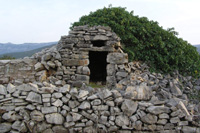 "Trim" (a small stone cottage) is the first building in which a human from neolithic (the new stone age) were staying after leaving the cave. His creation has been preserved till present day in its original form and building principle. Some of the conserved stone cottages were built on the foundations of the same buildings from neolithic without any mortar in their thick walls enabling pleasant temperatures both in summer and winter. There are two main shapes of "trim" on the island of Hvar: short stepped pyramid or round shaped 'trim' that gradually narrowes in its upper part to form a roof (this is more frequent shape). When you look at the "trim" from outside, pyramidal one is more pleasant for eye although you become completely aware of the order in the building technique of both types only if you enter them. It refers especially to the building technique of roofs that certainly required considerable skills. Depending on their location and purpose, there are also special variations of two main forms of stone cottages like a cottage with a protecting wall in front of the entrance, a type with steps across it, or two 'trims' with narrow passage between them and both entrances protected by the same wall.
"Trim" (a small stone cottage) is the first building in which a human from neolithic (the new stone age) were staying after leaving the cave. His creation has been preserved till present day in its original form and building principle. Some of the conserved stone cottages were built on the foundations of the same buildings from neolithic without any mortar in their thick walls enabling pleasant temperatures both in summer and winter. There are two main shapes of "trim" on the island of Hvar: short stepped pyramid or round shaped 'trim' that gradually narrowes in its upper part to form a roof (this is more frequent shape). When you look at the "trim" from outside, pyramidal one is more pleasant for eye although you become completely aware of the order in the building technique of both types only if you enter them. It refers especially to the building technique of roofs that certainly required considerable skills. Depending on their location and purpose, there are also special variations of two main forms of stone cottages like a cottage with a protecting wall in front of the entrance, a type with steps across it, or two 'trims' with narrow passage between them and both entrances protected by the same wall.
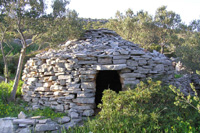 In the western part of the island of Hvar there are for sure more than 90 stone cottages. Such buildings can be also found in the Croatian part of the Adriatic cost including the interior of Istria and Dalmatia but there they are known by other names such as komarda, kazun, bunja, kucica.
In the western part of the island of Hvar there are for sure more than 90 stone cottages. Such buildings can be also found in the Croatian part of the Adriatic cost including the interior of Istria and Dalmatia but there they are known by other names such as komarda, kazun, bunja, kucica.
It is a logical thing that people have been using stone since anciant times for erecting solid buildings as a permanent solution for different purposes like place for keeping domestic animals or shelter for people during their work on the land.
The concentration of the same or similar buildings with the same building technique is the biggest in Mediterranean countries: Italy, Spain, France, Malta, Slovenia, Palestine, Egypt, Morocco (but also Ireland as well as some countries in the continental part of Europe like Germany and Switzerland).
Many stone cottages on the island of Hvar embellish its landscape which is wonderful in any case.
They are so numerous probably because of the abundance of stone as a material which enables a relatevely fast building as well as the fact that the creation of such cottages started in the new stone age and that it has been possible to build so many of them in a wide area in such a long time.
The fact that many of "trims" are on the private property should be respected, so if you visit such a place or if you approach a dry- stone wall, please don't try to move any stone used for their building.
UNESCO protected values: Lace from Hvar made of agave threads
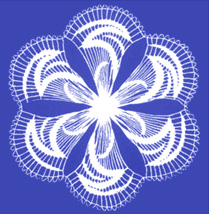
On the island of Hvar, which covers an area of 299 km² and has 12000 inhabitants, there are three assets protected by UNESCO.
Since recently the dedication to God is not the only mission of nuns in the Benedectine convent of the town of Hvar. UNESCO recognized the lacemaking tradition on the island of Hvar by putting the lace made by Benedictines on the list of the world cultural heritage. This recognition obliged the nuns to preserve their tradition. Benedictine nuns have been making lace for more than 150 years exclusively behind the walls of their convent established in 1664. The tradition requires that the skills of making these unique laces with cheerful motifs are taught only among Benedictines in Hvar. It is not hard for nuns to respect this tradition as they are dedicated to their work with so much love.
The lace of agave threads was given as a present to the pope Benedict. There's great demand for this lace not only among tourists who visit the town of Hvar but also all over the world.
Lacemaking in Lepoglava, Pag and Hvar are recognized and protected by UNESCO as a part of non-material cultural heritage. Unfortunately, due to the procedural error of the Ministry of Culture, the lace of Primosten was not put on the list of UNESCO. The Ministry couldn't afford such an error because the lace from Primosten is not less valuable than the others.
Non-material cultural heritage includes knowledge, skills, customs, tradition of a certaun society. The unique lace from the island of Hvar is exceptionally valuable asset which requires extraordinary skills and a lot of knowledge. It's a tradition on Hvar for more than 150 years.
Although the sale price of this lace is very high, it is not known that someone has tried yet to do something similar in this part of the world. The reason is probably the respect for the hard work of nuns or, which is more possible, the complicated technique of producing threads as well as the lacemaking technique itself. The price is high, but we can't say that the lace is expensive. Who could make such a beautiful lace from agave threads and moreover as a self-taught? (Maybe only nuns from from the Benedictine convent in Hvar.)
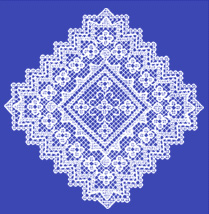
Local seafarers brought from the island of Tenerife, one of the Canaries, an exemplar of lace made from agave threads. (Tenerife, popular summer resort, is known as the only natural habitat of canary bird.)
It was necessary to examine the model at first, then to learn how to prepare threads and how to make lace. Nuns had to solve a lot of technical problems and many of their works were lost at the beginning. Little by little they created the lace which was more beautiful and richer ornamented than the model from the distant island.
It is difficult to distinguish the truth from the speculations in the stories about lacemaking technique in the Benedictine convent. I hope that sisters Benedictines won't resent me if my description of threads preparation process as well as lacemaking techniques are true. I am sure that some details miss.
At first threads are carefully separated from thick, juicy leaves of agave which must be at least three years old. Fastening threads by making knots , that nuns learnt from local fishermen, is apparently one of the crucial details for obtaining a quality, firm lace. It is important to obtain that a knot, which normally represents a thikness on a thread, becomes flat, completely joined with a thread.
Knots are immersed into the sea or water, then straightened with hands or a roller. Procedure is repeated until obtaining the unvisible junction as tight as the rest of the thread.
The phase of the preparation of threads is followed by the phase of patient knitting of laces from memory, without any pattern prepared in advance. The design of the lace should be imagined in every single detail before setting to work. There are three main techniques of embroidery: tenerife, antika and mreskanje (ruffling). Lace is usually made when the south wind jugo, which causes wet weather, blows. Due to the higher humidity during jugo it's easier to work with threads, i.e. they can be ruffled easier , put through or knotted without a danger of being broken.
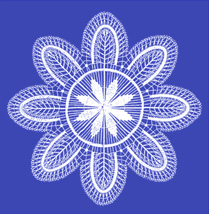
Although the laces are made of a fragile material, they can last for centuries if they are kept in a proper way. In the convent collection there are pieces of lace from 19 th century.
The best way to conserve laces is to keep them under glass without any chemical treatement, washing or ironing.
It is usually said that agave flowers once in one hundred years and then dies. It seems that the plant has no reason for living after showing all its beauty. Very romantic, but only partially true. Agave doesn't flower until the age of ten, and it usually fowers after 15-20 years. Then a stem usually grows up to the height of 5-6 m, supporting in its upper part a characteristic yellow flower. After flowering an agave withers and rots; and soon several new shoots appear on that place.
Agave americana started to spread on the Adriatic coast in 16 th century.
Three centuries later sisters from the Benedictine convent in the town of Hvar, on the island of Hvar make, from the same agave, magnificent lace that will outlive several times its creators.
UNESCO heritage on the island of Hvar: After the Cross
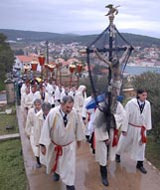
By Catholic calendar before Easter, on the eve of Good Friday, at the same time six processions start from six adjacent places in the central part of Hvar island. They follow one another around but never catch up. That night procession is not led by the priest but the cross.The same rule is valid for all parishes. Although it is question of six small processions they represent one event as Catholic tradition and it's called procession - "After the Cross".
That's the cross-bearer who carries the cross which is placed at the head of each procession and that's great honour. Cross-bearers are enrolled years in advance, even a decade in order to welcome their special day in life and to participate in the most honourable way in continual Catholic tradition of pious community.
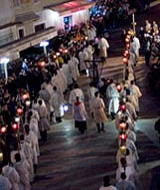
This traditional religious custom originated from common people spontaneously and not as the custom of the church. It developed after the commoners' rebellion on Hvar island (1510. - 1514.) led by Matija Ivanic. Rebellion was put down by the Venetian Republic in a very brutal way which included limbs amputation and hanging.
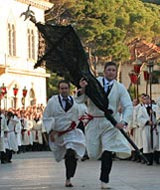
There is much of fascinating in folk-religious penitential procession "After the Cross". There are surprisingly beautiful motives which can be seen that night. Parishioners are trying to make the night procession unfogettable. However, the most fascinating thing is that local people don't let rebellion case fall into oblivion. It's not only question of nice tradition but of way of thinking. Before Hvar rebellion and after that islanders were at war, defending freedom, looking for sovereignty but that's rebellion in 1510 that united the inhabitants of the island. Procession that takes place without the clergy wasn't interrupted even during the World War II, in a time of refugees' camp. At that time procession was held in the remote desert reception center El Shatt.
During procession all churches in places Jelsa, Pitve, Vrisnik, Svirce, Vrbanj, Vrboska are clearly illuminated and each in its own way beautifully decorated. All lights in houses are switched on. A lot of people participating in procession, candle light and lanterns in the night and the whole atmosphere is special. It attracts an increasing number of curious people, pilgrims and tourists.
UNESCO list of intagible values is enriched by this special religious event on Hvar island.
Acapella songs: Ljubo Stipisic – Delmata and "klapa" singing

Ljubo Stipisic-Dalmata was born in 1938 in Split, but his roots are from the village Vrbanj on the island of Hvar.
I remember those days, in the late '80, when streams of tourist were walking across the Pjaca (the main square in Split town) in the summer twilight. That was the part of the day when klapas ( groups of singers who perform Dalmatian a capella songs) used to gather in organized or more often unorganized way on the frequented and acoustically tested parts of the Pjaca, usually under the city watch. Most of the walkers who were passing nearby didn't know for which purpose these people turned to each other in the circle, so that they didn't know they needed to become silent in order to hear extremely nice klapa song. The attention of the audience was not assured in advance.
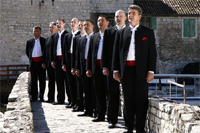
At that time none of the klapa singing lovers didn't care very much for performances in front of the microphone; they appreciated much more the performances, whether organized or unorganized, without microphones, loudspeakers and kilometers of wire, the performances which didn't take place on the multi-purpose stages but in the acoustically best parts of the Diocletian's Palace in the moment and the way that suited klapas the best.
As a klapa wasn't usually remarked before performing and as it didn't seem that something were going to happen, I used to notice such a reaction of tourists that I'll never forget.
That jolly murmur produced by tourists was simply unconditionally silenced , so smoothly by spontaneous, mute harmonisation of walkers' senses of sound. The silence was complete in the moment when the first sounds were heard, although it was difficult to determine where they were coming from. Then people remained like rooted to the ground, fascinated and with face expressions that seemed deeply absorbing pleasent tones of singers' voices.
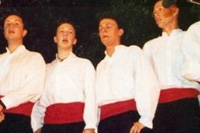
A wide range of feelings could be seen on the faces of the occasional, privileged audience. You could feel ranges of different voices: tenor, bass, baritone spanning two or three octaves, raising you into the air and then gently lowering, surprising you by their briskness or a higher tone floating somewhere above your head and then falling back into the circle that had been made by singers' bodies at the beginning - and finally becoming still.
For the next few minutes the klapa could't continue singing because their extraordinary performance met with loud applause that took so long. Afterwards the jolly murmur returned to the streets and everything was cyclically repeated : some voices from undeterminable direction were heard again, the voices that describe all traditional scenes of Dalmatia without exception. I am sure that many listeners wondered at that moment: "How did I deserve it?".
The song « Dalmatino poviscu pritrujena» ( Dalmatia exhausted by history) is accepted among Dalmatian people as a kind of Dalmatian anthem. It was written by Ljubo Stipisic- Dalmata.
For 50 years , like an archeologist with a brush, Ljubo Stipisic carefully removed dust from everything he considered valuable or interesting and inserted it into his book with the title « Anima Dalmatica». For all these years he gave his best to the klapa singing or it is better to say that he built in the past, the present and the future of klapa singing his exploring and collecting of everything valuable in Dalmatia.
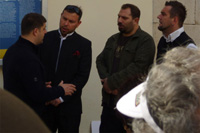
He is called Father of Dalmatian klapa singing and his name is usually accompanied by an artistic title like musicologist, ethno-musicologist, conductor, music producer, poet and painter. Half century of Dalmatian klapa singing was followed by the ear and the eye of this great collectioner of everything that is Dalmatian.
Recently, klapa music has been present in very different sorts of commercial music. One of the musicians who included klapa singing in his work is the son of Ljubo Stipisic- Delmata, Zlatan Stipisic Gibonni.
Whether the inserting of the elements of klapa singing in different songs is an ephemeral trend, maybe an inventive way of keeping klapa singing in mind or pure commercialization of that sort of music, only time can tell.
It is certain that klapa singing enriches different pieces of music and that it can intensify the experience. It is also certain that Dalmatian klapa singing is the way of music performing which transmits best to the auditor the pure essence of Dalmatian soul.
I don't remember when I had last time the opportunity to hear quality live performing of Dalmatian klapa singing as I used to attend in the late '80, without microphone and loudspeaker, without attention of audience assured in advance. I regret it very much because I think that it is one of the most beautiful souvenirs of Dalmatia.


